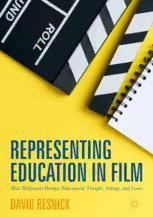
Representing Education in Film: How Hollywood Portrays Educational Thought, Settings, and Issues PDF
Preview Representing Education in Film: How Hollywood Portrays Educational Thought, Settings, and Issues
REPRESENTING EDUCATION IN FILM How Hollywood Portrays Educational Thought, Settings, and Issues DAVID RESNICK Representing Education in Film David Resnick Representing Education in Film How Hollywood Portrays Educational Thought, Settings, and Issues David Resnick School of Education Bar Ilan University Ramat Gan, Israel ISBN 978-1-137-59928-5 ISBN 978-1-137-59929-2 (eBook) https://doi.org/10.1057/978-1-137-59929-2 Library of Congress Control Number: 2017961546 © The Editor(s) (if applicable) and The Author(s) 2018 This work is subject to copyright. All rights are solely and exclusively licensed by the Publisher, whether the whole or part of the material is concerned, specifically the rights of translation, reprinting, reuse of illustrations, recitation, broadcasting, reproduction on microfilms or in any other physical way, and transmission or information storage and retrieval, electronic adaptation, computer software, or by similar or dissimilar methodology now known or hereafter developed. The use of general descriptive names, registered names, trademarks, service marks, etc. in this publication does not imply, even in the absence of a specific statement, that such names are exempt from the relevant protective laws and regulations and therefore free for general use. The publisher, the authors and the editors are safe to assume that the advice and information in this book are believed to be true and accurate at the date of publication. Neither the pub- lisher nor the authors or the editors give a warranty, express or implied, with respect to the material contained herein or for any errors or omissions that may have been made. The publisher remains neutral with regard to jurisdictional claims in published maps and institu- tional affiliations. Cover illustration: © Tatomm/iStock/Getty Images Plus Printed on acid-free paper This Palgrave Macmillan imprint is published by Springer Nature The registered company is Nature America, Inc. The registered company address is: 1 New York Plaza, New York, NY 10004, U.S.A. P reface This journey of a generation began during summer 1992 when I saw Baz Luhrmann’s film Strictly Ballroom. I walked out of that wonderful film with the epiphany that “It’s an informal education movie.” That led to my first article about education in film, “Strictly Subversive—Films of False Liberation” which appeared in Comparative Education Review in 1996. Over the years, seven more journal articles appeared, exploring the educa- tional dimensions of Hollywood films from various points of view. Teaching a course on “Film Images of Education” at my academic home, Bar Ilan University’s School of Education in Ramat Gan, Israel, advanced my research. This book is not a reprise of previous work. Part I is a methodology and rationale for the entire enterprise of exploring educational issues in film. I know of no similar effort elsewhere. Part II includes entirely new topics, like Art Education and Sports Coach as Educator. When I return to topics I have addressed previously, I do so from entirely new perspectives, like my use of Rosenak’s analytic framework in Chap. 6 on religious education. Primary thanks are due to my wife, Gail, and children, Leora, Talya, and Ezra, who urged me to produce this book. Ezra read the entire manu- script and made many valuable suggestions, both enriching the content and saving me from errors. I extend my thanks to colleagues and friends who read individual chapters as noted therein. My friend, Professor Moshe Rosman, has also been my best colleague in this venture—starting with the tip that to fully understand Scent of a Woman, best to see the Italian movie Profumo di Donna of which it was a remake. v vi PREFACE The Van Leer Jerusalem Institute, headed by Professor Shai Lavi, pro- vided a wonderful haven for the writing of the book. Zippi Hecht, assis- tant to the director, made the haven possible and Library Director Bayla Pasikov was helpful in many ways. They all have my thanks. Jerusalem, 2017 c ontents Part I Defining the Domain: Methodology and Rationale 1 1 Introduction 3 2 Defining “Education Movies” in Educational Terms 11 3 Education as Change: The Question of Changeability 27 Part II A Movie Close-up on Educational Themes 43 4 Sports Coach as Educator 45 5 Arts Education 73 6 Religious Education 95 vii viii CONTENTS 7 C ivic Education 115 8 The Rearview Mirror 149 Index 161 PART I Defining the Domain: Methodology and Rationale CHAPTER 1 Introduction The purpose of this book is to help people interested in education enrich their thinking by taking a serious look at selected Hollywood films. I take a broad view of education in a variety of settings, including informal edu- cation—like sports and the arts—as well as educational issues which are sometimes not “taught” at all, like the civic education students absorb from the political life of their schools. Some of the educational issues I explore are “philosophical,” for which animated films are a particularly rich source of material. Even when some of the films are school-based, I do not focus on classroom or instructional issues, topics thoroughly cov- ered by other books in the field (Dalton 2017). Why Movies? Movies are a powerful source of what Lindblom and Cohen (1979) call “ordinary knowledge,” the knowledge people use to make most of their everyday life decisions. Some movies educate us about things we have never experienced first-hand, like war, outer space, and vampires.1 Closer to this project, some movies flesh out educational topics people have already had experience with, like school politics and sports coaches. Other movies may provide “knowledge” on educational topics few have experi- enced directly. For example, most of the American public has never attended—or even visited—a private school, other than in the movies. This situation is probably true for many of those who shape education © The Author(s) 2018 3 D. Resnick, Representing Education in Film, https://doi.org/10.1057/978-1-137-59929-2_1
